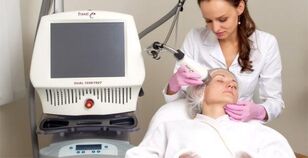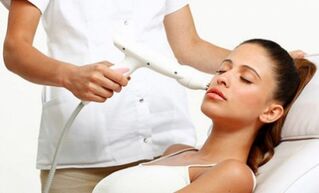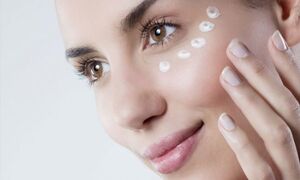Aging is a natural biological process that affects all tissues of the human body, including those that comprise a person's external appearance. At the same time, facial tissues are more susceptible to aging than others, because they are constantly influenced by environmental, chewing, facial and speech factors. As a human type of “visiting card”, the issue of preserving and rehabilitating the youth of the facial skin is extremely important and relevant. Among the many methods and techniques used today to solve this problem, laser facial rejuvenation deserves special attention.
At the heart of this method is the fractional effect of a laser beam on the skin. The laser stream is divided into many thinner beams that affect microscopic areas of the skin, located at a strictly specified depth, and evaporate. The intact cells located between these areas stimulate the active production of collagen and elastin - two main “building materials”, which become smaller and smaller in the human body with age. After this procedure, the skin color improves, fine and medium wrinkles are corrected, bags are removed under the eyes and the face oval is tightened. At the same time, the rehabilitation period is reduced to a minimum. Fractional laser resurfacing can be used not only as a stand-alone method, but also to improve the results of plastic surgery or laser skin resurfacing.

Lasers used for fractional laser resurfacing
For the first time in the world, the American company Palomar Medical Technologies received a patent for the principle of fractional laser exposure. Fractional laser systems are currently represented by a number of laser technology companies. The most prevalent laser systems are from Palomar and Fraxel, Affirm lasers from the famous American company Cynosure, GentleYAG lasers from Candela and others. Since all of these views have a common principle of action, the outcome of the procedure is largely determined by the professionalism of the specialist in the procedure.
Contraindications to the laser refresh procedure
The total violations of the procedure are:- Pregnancy, lactation.
- Focus of the inflammatory process in the affected area. Psoriasis and dermatoses.
- Focus herpes infection in the affected area. Chemical peeling of the proposed treatment area performed less than two weeks prior to the procedure.
- Oncological diseases.
- Systemic diseases of the blood, immune system, connective tissues.
- Diabetes mellitus in the detoxification phase.
- Serious forms of hypertension and coronary heart disease.
- Varicose veins in the procedure area.
- Tendency to form celiac scars.
- Family history of vitiligo.
Relative contraindications include active sun exposure in the last three weeks before the procedure, that is, the presence of fresh sunburn, as well as superficial and midline peels made in the treatment area less than three weeks before the procedure.
Benefits of Fractional Laser Renewal
Thanks to the point effect, the damage to the skin is minimal, and all traces disappear after the procedure within 3-4 days.The method allows you to treat large parts of the skin in one procedure, while maintaining and activating the regenerative capacity of the skin, ensuring rapid recovery and long-term growth of the positive effect.
The procedure does not require anesthesia, it can be performed in the area of the neck, décolleté and eyes.
Side effects are rare. Possible complications include temporary appearance of red-purple spots in the treatment area, slight and rapid itching, activation of herpes infections, changes in skin texture, including burns, peeling and crusting. Scarring, hyper- and hypopigmentation of the skin in the procedure area are extremely rare, but they can be permanent.
What is the full course of laser refresh procedures
One session of fractional laser exposure lasts 20-40 minutes, depending on the nature of the problem and the area of the treated area. Repeated procedures are performed in 3-4 weeks. Usually requires a total of 3-4 sessions. The greatest positive effect occurs within three months after the last procedure. It is recommended to do maintenance sessions once every 10-14 months.

What to do after the laser facial rejuvenation procedure
The sensation of a slight burning sensation after the procedure disappears in 1-2 hours, with a slight redness and swelling for 1-3 days. During this period, external agents (creams, ointments, sprays) containing dexpanthenol should be used, for example, Bepanten, Panthenol, D-Panthenol. After the listed symptoms have disappeared and before the next procedure, a cream with hyaluronic acid is applied.
You can take a shower and wash on the day of the procedure, but it is best to stay by the sauna and pool. Foundation can be used days after the procedure.
It is mandatory to use sunscreen with a protective factor of at least 30, because at this time the metabolism of the skin is activated, and it becomes very sensitive to the sun's rays.
After the procedure, it is necessary to adhere to the recommendations of the specialist who performed the procedure. The choice of cosmetic products, frequency and duration of their use are determined individually and depend on the skin type and its characteristics.
Fractional laser rejuvenation is a cosmetic procedure, and the skin is exposed to a laser array made of microbes. The aim of this effect is to activate regenerative processes and collagenogenesis. This is a relatively new hardware technique, but already very popular. Alternatively, it is called fraxel, fractional laser resurfacing or photothermolysis.
Principle of operation and types of laser fractional refresh
How does a fractional laser work? Micro-rays emitted by the apparatus emit a heat shock, in response to which the “lazy” skin cells begin to function more actively. To repair the damaged area, they divide faster. Old cells that were inoperative die, giving way to the young ones. Warming of the deep layers of the skin is accompanied by partial denaturation of proteins, as well as the formation of new components of the extracellular matrix, including elastin and collagen.
According to the depth of impact, a distinction is made between abutive and non-ablative laser refraction. The first is superficial and grind-like. Moisture treatment of the upper layers of the skin is accompanied by moisture evaporation, damage to the epidermis. After healing, the skin becomes more toned, is relieved and its color is leveled. During non-ablative photothermolysis, the laser acts on the deep layers of the skin. In this case, no open wound is created.
Each type of refresh has pros and cons. Therefore, the effect of abduction laser resurfacing is observed after the first procedure. With this method, you can get rid of deep wrinkles and age spots, acne, stretch marks, scars. With a non-ablative procedure, there is no risk of infection and the rejuvenating effect has been observed for several years. This type of photothermolysis is recommended for people under 40 years of age, with the first signs of aging: smooth wrinkles, reduced turgor.
Indications and contraindications for the procedure
It is worth resorting to the photothermal procedure, if available:
- Laxity, sagging skin.
- Both smooth and deep wrinkles, peaked legs.
- Pigmentation of any origin.
- Increased secretion of sebum.
- Enlarged pores, prone to acne. Scars, stretch marks, post-acne.
- vascular "stars" (couperosis).
- Dull Complex.
- Allergy, psoriasis. Autoimmune diseases.
- Pregnancy, breastfeeding.
- Diseases of blood.
- Skin infections, inflammation in the area of the proposed treatment.
- Any chronic diseases that are in the detoxification phase. Oncology
- .
- Increased body temperature.
- Diabetes mellitus.
- Tendency to form celiac scars.
- Titimeas.
Features for laser refresh
Preparation for the fractional photothermolysis procedure involves refusing to visit the solarium and the beach for two weeks. All this time, you can not cleanse your skin, make chemical peels, take sulfonamides, fluoroquinolones, tetracyclines. Three days before the procedure, they stop going to the pool, the bathroom, the sauna, treat the area of the alleged exposure to cosmetics containing alcohol. To prevent complications, the cosmetologist may prescribe antiviral and antibacterial drugs for this period. The day on the eve of the procedure should be performed without alcohol and cigarettes, refraining from going to the gym.
Before laser treatment, the skin is cleansed of cosmetics and impurities. The effect of the laser is generally perceived as an unpleasant sensation, but pain relief may sometimes be needed. In this case, the beautician applies an anesthetic to the prepared skin area. After the ointment works, it goes on to treat the skin with a laser. The length of the procedure depends on the size of the treatment area and ranges from several minutes to an hour. Eventually, the skin is soaked with a nourishing cream.
The first days after the procedure, you should not use alcohol-based products, the body parts in which photothermolysis has been subjected to compression linen. It is recommended to exclude physical activity for a week, visit the pool, sauna or bath, limit the time spent on the street. The skin is moisturized with a special cream three times a day. And so for half a month. It is undesirable to make peels, use cosmetics with retinol acid, salicylic acid. For two months it is necessary to use a cream with a sun protection factor of 35 or more.
How many procedures do you need to achieve the result? What effect can you expect?
The recovery period after laser fractional renewal lasts from 3 to 7 days. The pace of recovery largely depends on lifestyle. Alcohol consumption, smoking, excessive activity, unbalanced diet, insomnia and anxiety can all delay the regenerative processes.
For the first three days after laser exposure, skin redness and slight swelling may occur. Aesthetics and cooling of the skin can help reduce the feeling of discomfort. Usually if skin tension is felt within a week, there are scaly places. A side effect of the procedure can be a bronze tank, which disappears spontaneously after half a month.
Continuous yield occurs after fractional photothermolysis after 2-5 procedures. Specifically, only a cosmetologist can determine the number of sessions, based on the initial data. The intervals between procedures are 3-4 weeks. Laser fractional rejuvenation prevents aging processes: wrinkles disappear or become less noticeable, turgor increases, pore intensity decreases, and the complexion is improved. This method is an effective tool in the fight against scars, pigmentation, post-acne, stretch marks.
Laser fractional rejuvenation is one of the three most popular hardware cosmetic procedures. Its advantages include efficiency, short healing period, physiology. The result is visible after the first procedure and lasts up to three years. The method has a wide range of indications. The depth of laser exposure can be selected.
A woman of any age wants to see beautiful skin in the mirror, but not everyone is ready to go under the knife of a plastic surgeon.
In this case, fractional rejuvenation comes to the rescue using a laser, which modern cosmetology takes one of the first places in anti-aging procedures.
Types and methods of exposure
Relative PhotothermolysisThere are two methods of photothermolysis, each suitable for different situations. The right choice in favor of the best choice will help the cosmetologist make the first appointment.
This method is ideal for rejuvenating skin that has just regenerated naturally.
The laser-assisted microdamage network only affects the upper layers of the epidermis, forcing it to regenerate in a short time.The result becomes visible after the first procedure, as soon as the wounds heal.
Non-ablative PhotothermolysisThis method is a slightly more serious intervention. The laser beam enters the deep layers of the epidermis, ignoring the outer cells.
Damagepromotes elastin and collagen production, as in ablative photothermolysis.
The healing process takes longer and the effect becomes more noticeable. Suitable for removing serious facial problems.
Readings
Anyone who wants to refresh without serious braces can use this method.
Fractional laser treatment combats many human imperfections, including:- highly pronounced wrinkles on top; nasolabial folds
- ;
- thread of bean legs around the eyes; epidermis
- "flowing down";
- skin pigmentation, scars, scars, spider veins; Problem
- enlarged pores, acne.
has been shown to be very effective in eliminating all these problems.
The only caveat is that depending on the severity of imperfection, some procedures may be required.
Contraindications
Like any other external impact on the body, laser fractional rejuvenation has its own violations, which prevent it from resorting to such a procedure.
This includes:
- presence of acute inflammation of the face;
- infectious, fungal skin lesions; Diseases
- of the epidermis - psoriasis, eczema; excessive dryness
- of the skin;
- malignant neoplasms in the body;
- history of epilepsy; heart disease
- ; varicose veins
- on the face; herpes
- in the acute phase; pregnancy
- , breastfeeding; Immune deficiency states
- ; bronchial asthma
- , severe allergic reactions;
- neurological diseases.
All contraindications are conditional, that is, the beautician weighs all risks for the patient.
Sometimes you should first get treatment for skin problems or wait for the remission of chronic diseases, after which it is still renewed.
Preparation
Since the intervention is not a surgical operation, no serious preparation is required. First, you should consult a cosmetologist who will assess the condition of the skin, and also give recommendations on the necessary method of photorejuvenation.
The patient is obliged to tell the doctor about all the conditions and diseases in history, as well as the exacerbation of chronic diseases in the last six months.
If available, the specialist will advise you to visit specialist doctors to assess the safety of the procedure.
You should also have a blood and urine test to identify or rule out inflammatory processes in the body. The date of the first visit is then set.
Execution
Fractional laser skin rejuvenation in the facial area is performed on an outpatient basis, that is, the patient enters, is treated, then goes home.

The cosmetologist will first apply an anesthetic cream or lidocaine-based ointment to the epidermis.
In fact, the procedure is not too painful, so sometimes therapy is done without going through this stage.
Be aware that the use of local anesthetics slightly prevents the subsequent natural regeneration of the skin.
The patient then lies down on the couch, and the specialist adjusts the penetration depth of the laser beam on a special device. The device is focused on certain parts of the epidermis, into which the laser penetrates deep.
Manipulationslast from half an hour and more, depending on the area to be treated with the device. During the procedure, the patient may experience a slight tingling sensation, as well as an unpleasant odor.
Immediately after the session, a grid of red dots is visible on the face, the skin is red, slightly swollen, so it is best to take care of the way to return home in advance.
Potential Complications
Fractional renewal does not exclude difficulties. In some cases, they are normal and disappear within a few days.
Others develop due to inexperience of the cosmetologist or lack of facial care during the rehabilitation period.
What is not the norm:
- severe pain or swelling at the spot exposed to the laser beam;
- lesions do not heal in two weeks; Pigmentation and scars appeared
- .
Mild redness, scaling and itching of any type of epidermis is a predictable condition.
Such effects disappear on their own within 1-2 weeks, leaving no visual defects behind.
Recovery
The outcome of the procedure has a major impact on the patient's own behavior. It must carefully monitor the skin, protect it from aggressive influences on the environment, without applying decorative cosmetics during healing.

General guidelines:
- The first three days of the wound should be lubricated with a dexpanthenol-based ointment,will contribute to the rapid healing of micro-materials. Afterwards, it is recommended to use a mild moisturizer with hyaluronic acid, recommended by the beautician.
- Washing is not prohibited.For 2 weeks, the epidermis should not be exposed to strong heat, so it is better to refrain from baths and saunas, than to take hot baths.
- You should not go outside without sunscreen,and it is best to choose protection out of 50. If this is not done, hypersensitivity will appear. The cosmetic product should be applied until it is completely cured, even if the winter is outside.
After a few weeks, it is recommended to go back to the specialist who performed the fractional laser resurfacing. It must assess the condition of the skin on the face, excluding complications.
ForecastThe result can be seen immediately after healing, unless the imperfections were very pronounced. Wrinkles or deep scars need to be removed with some treatments.
Visually, the skin is calmer, has a natural color, the face is built and blooms in 99% of cases.
percent is focused on unforeseen circumstances, inadequate care, and lack of medical qualifications.
Advantages of the method
For many patients, this method has significant advantages. By choosing photothermolysis, one gets the following:
- low cost with high efficiency;
- without pain; Effect
- even from one procedure; non-invasive
- ;
- lack of strong side effects.
In addition, the effect of the laser solves several problems of the aesthetic component of the epidermis at the same time, which is good news.
Disadvantages
If you choose the wrong clinic for rejuvenation or do not strictly follow the recommendations of the cosmetologist, you can earn huge age spots on half a person, which will not be easy to remove.
In addition, laser treatment lasts a long time, when the patient feels an unpleasant odor of damaged skin, which not everyone is able to withstand.Another disadvantage is the incomplete result from one procedure with deep depression, scars and wrinkles.
Review of comments
Fractional rejuvenation is very popular in cosmetology. Every year more and more women choose laser instead of surgical scalpel.














































































